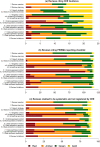Standards of conduct and reporting in evidence syntheses that could inform environmental policy and management decisions
- PMID: 39294776
- PMCID: PMC11378768
- DOI: 10.1186/s13750-022-00269-9
Standards of conduct and reporting in evidence syntheses that could inform environmental policy and management decisions
Abstract
Accurate, unbiased and concise synthesis of available evidence following clear methodology and transparent reporting is necessary to support effective environmental policy and management decisions. Without this, less reliable and/or less objective reviews of evidence could inform decision making, leading to ineffective, resource wasteful interventions with potential for unintended consequences. We evaluated the reliability of over 1000 evidence syntheses (reviews and overviews) published between 2018 and 2020 that provide evidence on the impacts of human activities or effectiveness of interventions relevant to environmental management. The syntheses are drawn from the Collaboration for Environmental Evidence Database of Evidence Reviews (CEEDER), an online, freely available evidence service for evidence users that assesses the reliability of evidence syntheses using a series of published criteria. We found that the majority of syntheses have problems with transparency, replicability and potential for bias. Overall, our results suggest that most recently published evidence syntheses are of low reliability to inform decision making. Reviews that followed guidance and reporting standards for evidence synthesis had improved assessment ratings, but there remains substantial variation in the standard of reviews amongst even these. Furthermore, the term 'systematic review', which implies conformity with a methodological standard, was frequently misused. A major objective of the CEEDER project is to improve the reliability of the global body of environmental evidence reviews. To this end we outline freely available online resources to help improve review conduct and reporting. We call on authors, editors and peer reviewers to use these resources to ensure more reliable syntheses in the future.
Keywords: CEEDER; CEESAT; Environmental evidence; Evidence synthesis; Evidence-informed decision making; Review reliability.
© 2022. The Author(s).
Conflict of interest statement
All authors of this article contribute to CEEDER voluntarily. We declare no competing interests.
Figures



References
-
- Collaboration for Environmental Evidence. Guidelines and standards for evidence synthesis in environmental management. version 5.0 (AS Pullin, GK Frampton, B Livoreil & G Petrokofsky, Eds). 2018. www.environmentalevidence.org/information-for-authors.
-
- Haddaway NR, Pullin AS. The policy role of systematic reviews: past, present and future. Springer Sci Rev. 2014;2:179–83. 10.1007/s40362-014-0023-1 - DOI
-
- Haddaway NR, Macura B, Whalley P, Pullin AS. ROSES RepOrting standards for Systematic Evidence Syntheses: pro forma, flow-diagram and descriptive summary of the plan and conduct of environmental systematic reviews and systematic maps. Environ Evid. 2018;7:7. 10.1186/s13750-018-0121-7 - DOI
LinkOut - more resources
Full Text Sources
Miscellaneous
